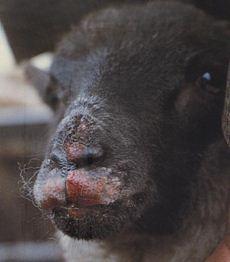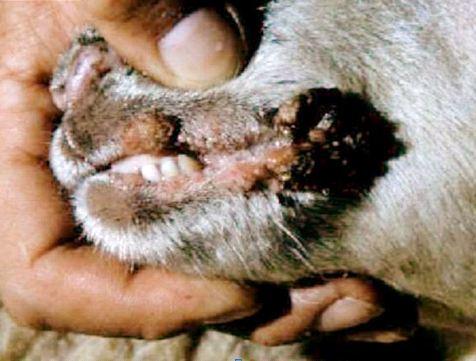Orf
 |
| Orf Symptoms |
|
© Hugh Cran, Nakuru, Kenya
|
Local names: Gabbra: abdara gala / Samburu: abturo / Somali Ethiopia: afdhalow /
Common names: contagious pustular dermatitis
Description: Viral skin disease
| WARNING: Notifiable disease! If you suspect an animal has Orf, you must inform the authorities immediately. |
Orf is an infectious viral skin disease of mainly sheep and goats. It mainly affects the lips of young animals. The disease is more severe in goats than in sheep. It can also affect wild sheep and goats. Humans are occasionally infected and the disease has been reported in dogs that have scavenged on infected carcases.
It is characterised by the development of pus-filled and scabby wounds on the muzzle and lips of lambs and kids, by the appearance of similar lesions on the teats of nursing ewes and nanny goats and it can also produce lesions on the teats of cows.
The cause is a pox virus related to that which causes Pseudo Cow Pox and Bovine Papular Stomatitis. The disease occurs worldwide. It occurs mainly in young lambs and kids and occasionally in mature animals which do not have immunity from natural exposure.
Mode of spread
This is probably the most common viral disease of sheep. It is spread by contact. The source of new outbreaks in sucking lambs is believed to be a flare up of a persistent infection in a stressed ewe following lambing, not, as was previously thought, from scabs lying on the pasture. The virus then spreads rapidly to other lambs in the flock, both directly and indirectly. The incidence within a flock may be as high as 90%. The few deaths which occur are the result of extension of wounds within the respiratory tract, but the mortality rate may reach 15% if the lambs are badly cared for or if secondary infection or fly strike occurs.
Epidemics tend to occur twice yearly - the first peak is associated with the disease in sucking lambs, the later one with susceptible stock lambs. But sporadic cases can occur at any time.
The disease is commonest in lambs aged 3-6 months, although lambs aged 10-12 days and adults can be severely affected. Outbreaks can occur at any time but are most common in dry conditions. Recovered animals are solidly immune for 2-3 years but they do not transfer this immunity in their colostrum to their lambs, which are therefore susceptible to infection.
In humans typical wounds occur at the site of infection, usually an abrasion infected while handling diseased sheep, or milking infected cows or by accidental means when vaccinating sheep. The lesions are very itchy and respond poorly to treatment.
Infection only occurs if there is a break in the surface of the skin or the lips. The rapid spread during dry conditions may be due to scratches on the skin caused by dry feed, allowing a ready entry of infection. Spread in a flock is very rapid and occurs by contact with other infected animals or non-living objects. Ewes nursing affected lambs often develop crops of lesions on their teats which sometime lead to mastitis. As a result lambs are unable to suckle and may suffer from starvation.
 |
| Orf lesion |
|
© R. Paul Kitching
|
Signs of Orf
- The first wounds develop at the corners of the mouth, from here spreading onto the muzzle and nostrils and, to a lesser extent, into the mouth
- Occasionally wounds are found on the feet, usually between the toes or around the coronet
- Ewes nursing infected lambs may develop wounds on the udder and the teat may become encrusted with multiple wounds
- The wounds start as small pimples and progress pus-filled wounds before encrusting. Several small wounds may join together to form large scabs
- The scabs often split and are sore to the touch. They crumble easily but are difficult to remove from the underlying granulation
- Affected lambs suffer a severe setback because of restricted suckling and grazing
- During the course of the disease - 1-4 weeks- the scabs drop off and the tissues heal without scarring
- Lesions may also develop at castration and docking sites, and on the crown of the head of hornless rams due to head butting.
Diagnosis
The wounds are characteristic. However they must be differentiated from those of viral Ulcerative Dermatosis, which destroys tissue and causes ulcers around the nose, mouth, legs and on the penis, prepuce and vulva of older sheep. It must also be differentiated from Strawberry Foot Rot, caused by the fungal organism dermatophilus cogolensis, which usually occurs on the lower limbs, from Bluetongue and from Sheep and Goat Pox.
Treatment
There is no specific treatment. Antibiotics may help to combat secondary infections, and soft palatable food should be provided.
People should exercise caution when handling infected sheep, as lesions, usually confined to the head or face, can spread at a rapid rate and be distressing.
Prevention and Control
In the early stages of an outbreak, affected animals should be isolated and the remainder vaccinated. Vaccination is of little value when a large number of animals are already infected.
Persistence of the disease in a flock is common and in such circumstances the lambs should be vaccinated when about 1 month old. A small amount of live vaccine is brushed over light scarification of the skin, usually on the inside of the thigh.
For best results a second vaccination about 2-3 months later is suggested.
A week after vaccination there should be a local reaction with the formation of scabs at the site of vaccination and vaccinated animals should be segregated from unprotected stock until the scabs have fallen off.
Sheep that have recovered from natural infection are highly resistant to re-infection and vaccination is completely effective for at least 2 years.
